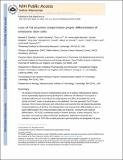Loss of Tet Enzymes Compromises Proper Differentiation of Embryonic Stem Cells
Author(s)
Dawlaty, Meelad M.; Breiling, Achim; Le, Thuc; Barrasa, M. Inmaculada; Raddatz, Günter; Gao, Qing; Powell, Benjamin E.; Cheng, Albert W.; Faull, Kym F.; Lyko, Frank; Jaenisch, Rudolf; ... Show more Show less
DownloadJaenisch_Loss of tet.pdf (1.081Mb)
PUBLISHER_CC
Publisher with Creative Commons License
Creative Commons Attribution
Terms of use
Metadata
Show full item recordAbstract
Tet enzymes (Tet1/2/3) convert 5-methylcytosine (5mC) to 5-hydroxymethylcytosine (5hmC) and are dynamically expressed during development. Whereas loss of individual Tet enzymes or combined deficiency of Tet1/2 allows for embryogenesis, the effect of complete loss of Tet activity and 5hmC marks in development is not established. We have generated Tet1/2/3 triple-knockout (TKO) mouse embryonic stem cells (ESCs) and examined their developmental potential. Combined deficiency of all three Tets depleted 5hmC and impaired ESC differentiation, as seen in poorly differentiated TKO embryoid bodies (EBs) and teratomas. Consistent with impaired differentiation, TKO ESCs contributed poorly to chimeric embryos, a defect rescued by Tet1 reexpression, and could not support embryonic development. Global gene-expression and methylome analyses of TKO EBs revealed promoter hypermethylation and deregulation of genes implicated in embryonic development and differentiation. These findings suggest a requirement for Tet- and 5hmC-mediated DNA demethylation in proper regulation of gene expression during ESC differentiation and development.
Date issued
2014-04Department
Massachusetts Institute of Technology. Computational and Systems Biology Program; Massachusetts Institute of Technology. Department of Biology; Whitehead Institute for Biomedical ResearchJournal
Developmental Cell
Publisher
Elsevier
Citation
Dawlaty, Meelad M., Achim Breiling, Thuc Le, M. Inmaculada Barrasa, Günter Raddatz, Qing Gao, Benjamin E. Powell, et al. “Loss of Tet Enzymes Compromises Proper Differentiation of Embryonic Stem Cells.” Developmental Cell 29, no. 1 (April 2014): 102–111.
Version: Author's final manuscript
ISSN
15345807